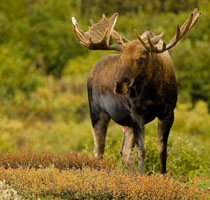
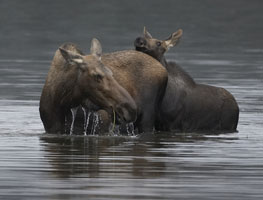
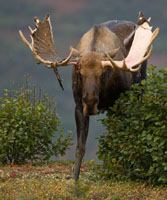
On any Photo Tour to Denali, seeing this continent's highest mountain, Denali, is a real treat, as clouds often obscure a view. This year, we saw the mountain 8 of the 9 days we were at the Park, an absolutely unprecedented string of luck for us and for about 99% of Denali's park visitors. But that wasn't what really defined this year's tour, for this year truly was.



Again, our luck was unprecedented, for moose are usually one of the more difficult animals to obtain good shots of, and this year we had a series of wonderful opportunities. Our first full day in Denali is always limited to the area around Wonder Lake, as the management of North Face Lodge, our base, correctly feels that folks are tired from their long travel day into the park that encompasses the transit day into the park. While this may sound limiting, the area around Wonder Lake - the area closest to the Lodge where we photograph - is often our photographer's favorite photo location in the park. On 2005's trip it was, by a majority, and several folks, including myself, picked it as our favorite location for our 2007 trip as well. But I digress...

On our first morning Denali greeted us with clear views, and we spent the first part of our morning shooting the mountain landscape. A professional photographer friend of our's, Tom Walker, happened by and informed us that a few miles up the road he'd seen a moose close, and supposed it might still be there. We quit our mountain shots in seconds, for an opportunity for moose can be fleeting, and packed back into the bus. The moose was there, in the tundra, and we vacated the bus and, once another NFL bus was finished viewing, we moved in closer for a better view. While we watched the moose entered a shallow pond, presented some great reflections, and then climbed back ashore where it snuggled into a bush and lay down. The Wonder Lake area is our 'macro day,' and we normally devote most of our time to shooting the tundra and tundra macro details when we're in this area, partly because we're forced, by the schedule, to stay in one area and cannot cruise the park looking for game. It was sunny and, without the effort involved in using a diffuser, macro shots were going to look pretty poor, looking dry and potentially contrasty. The moose was our best bet and, to our group's credit, everyone was content to sit down in the tundra, have a late picnic/field lunch, and wait for the moose to wake up and resume feeding. Almost two hours later it did just that, and we were rewarded with another great series of the moose feeding in the nearby pond. While antler shape defines an individual moose, this one was particularly distinctive, having a white racing stripe on the back side of its right antler. We'd come to know this moose well.
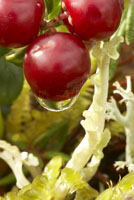
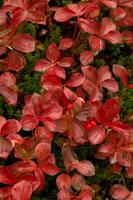
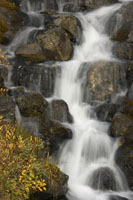
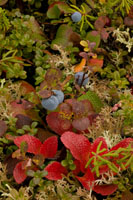
Our first day ended with an hour's vigil at a nearby, roadside beaver pond. After an hour's wait, a pair of beaver departed their lodge and calmly floated before us. The wait wasn't necessary, actually, as the beavers generally started their activity around 5:15PM, and we had simply arrived earlier hoping they might become active while the light was higher. At any rate, we nailed the beaver as it often swam or drifted passed closer than the minimum focus on my 500mm lens!
 Later
in the week we encountered our bull moose again quite close to
the road, providing us with lucky shots in a heavy rainstorm.
Just minutes earlier I had started what was supposed to be a long
tundra hike to look for moose and caribou, but fortunately Mary
spotted the moose just down the road and called me back. Just
minutes later a thunderstorm developed, and I was very happy that
we were all shooting the moose from inside the dry vehicle.
Later
in the week we encountered our bull moose again quite close to
the road, providing us with lucky shots in a heavy rainstorm.
Just minutes earlier I had started what was supposed to be a long
tundra hike to look for moose and caribou, but fortunately Mary
spotted the moose just down the road and called me back. Just
minutes later a thunderstorm developed, and I was very happy that
we were all shooting the moose from inside the dry vehicle.
One morning we left the Lodge at dawn, and almost immediately we spotted a cow moose near Wonder Lake. It didn't offer any shots so we moved on, and within minutes spotted our 'racing stripe' bull moose. Like our other encounters, it was close to the road but this time it was actively stripping velvet from its antlers. I'd never seen this before, and both Mary and I (and the group, of course) were amazed that the moose essentially cleaned its antlers of velvet in a two hour period. It made for some spectacular shots, with baseball mitt-sized slabs of velvet often hung from one or both of the moose's pal mated antlers. While we filmed the moose the cow that initially prompted our stop joined the bull, then walked on by. The bull moose followed, as did we, and for about two hours we were treated to the best moose shoot we'd ever had.
 On
our last day, again a macro day around Wonder Lake, Mary and Jim
spotted a cow moose and calf on the opposite shoreline of the
lake as we drove by. We stopped, and to our amazement the moose
and her calf stepped into the water and began swimming across
the lake, toward us. We filmed her journey, which ended on our
side of the shoreline, whereupon the cow moose walked right passed
us and our bus and continued through the tundra, so close that
those of us who did not run backwards had too much lens to keep
her in the frame!
On
our last day, again a macro day around Wonder Lake, Mary and Jim
spotted a cow moose and calf on the opposite shoreline of the
lake as we drove by. We stopped, and to our amazement the moose
and her calf stepped into the water and began swimming across
the lake, toward us. We filmed her journey, which ended on our
side of the shoreline, whereupon the cow moose walked right passed
us and our bus and continued through the tundra, so close that
those of us who did not run backwards had too much lens to keep
her in the frame!
Finally, on our departure day as we drove out of the park we spotted 5 more moose, including a good size bull half-heartedly sparring with a small bull. We didn't have time to shoot (the bus out has a schedule to meet) and all of our big lenses were packed for this transit day, but nonetheless it was a great sight to end with, especially as it racked up another series of great moose sightings.
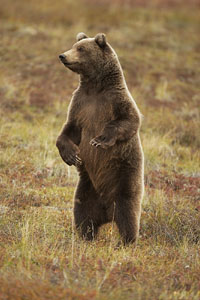 We
had other wonderful shooting opportunities as well, including
our very best tundra Grizzly Bear with Cubs that put on a show
for nearly two hours within close shooting distance of the bus.
At one point, another sow (female griz) joined the mother and
two cubs the group was shooting and everyone present witnessed
some wonderful behavior involving threat displays and signs of
intimidation. The shots were superb - the best ever.
We
had other wonderful shooting opportunities as well, including
our very best tundra Grizzly Bear with Cubs that put on a show
for nearly two hours within close shooting distance of the bus.
At one point, another sow (female griz) joined the mother and
two cubs the group was shooting and everyone present witnessed
some wonderful behavior involving threat displays and signs of
intimidation. The shots were superb - the best ever.
I say 'everyone present' because I wasn't there. Four other photographers and I had spotted some very distant Dall sheep and decided to hike out to them, and climb the steep slope they were on, to get some shots. Doing so, we missed the grizzly show, but we did get the sheep on the toughest hike I've ever made to shoot Dall sheep.
We'd guessed it would take us about 45 minutes, walking hard, to reach the base of the slope where the sheep rested, and we figured it'd take about a half hour to climb up to a level where we could shoot the sheep. To our horror, as we neared the sheep we discovered they had moved, leaving the what looked to be easy to climb hillside for the steep wall of a talus slope. We changed plans and headed for a closer ridge where we hoped we'd encounter the sheep if they continued moving our way.As it turned out, we were right on with the estimate for how long it took to reach the base of the slope, but when we started the climb two of our five-party group dropped out. Another almost did, but we were pretty sure we could get to where we needed to go and the three of us continued, upward, climbing a slope whose steepness rivaled ascending a ladder.
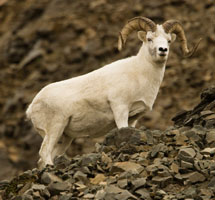 As luck
would have it, another, larger group of Dall sheep were on the
ridge above us, and it was that group we eventually filmed. Our
original group stayed on the distant talus slope and would have
been disappointingly distant subjects if we'd had climbed our
original ridge. Although a tough (an understatement here) climb,
it was worth it and for the three of us that made it (Steve Berkowitz
and Jim Conley and me) the trip, and photos, were the highlight
of the week.
As luck
would have it, another, larger group of Dall sheep were on the
ridge above us, and it was that group we eventually filmed. Our
original group stayed on the distant talus slope and would have
been disappointingly distant subjects if we'd had climbed our
original ridge. Although a tough (an understatement here) climb,
it was worth it and for the three of us that made it (Steve Berkowitz
and Jim Conley and me) the trip, and photos, were the highlight
of the week.
We also had our best fox shots, ever, as a pair of cross fox (this year's young, I assumed) repeatedly covered a stretch of roadside that brought them within frame-filling distant of our lenses on several different days. Cross foxes are a color phase of the Red Fox, Vulpes vulpes, marked by a dark colored back stripe and dark shoulders, making a +, a cross, if the animal was stretched out on a trapper's skinning board. It was great fun shooting the fox, although frustrating, too, because it never seemed to stop and, when running passed, it proved a real challenge to keep within the frame and in focus!
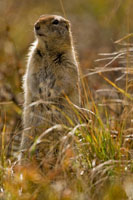
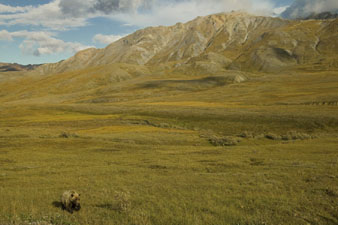
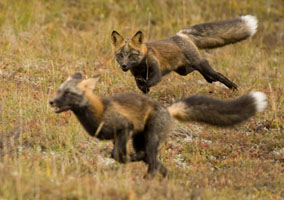
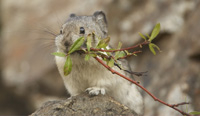 On
another day I'd hiked a steep hillside looking for Dall sheep
and discovered the home of a little Collared Pika. Pikas look
like Chinchillas (an Andes mountain rodent) but pikas are related
to rabbits and they are, by any definition, cute. Fortunately
one of the NFL's drivers told us of another spot for pikas --
one that involved an easy walk across the tundra and not a lung-busting
climb, and our group set up at the base of a talus slope to await
its appearance. After a 15 minute wait a pika appeared, and over
the next hour or so it scampered across the rocks, giving everyone
in our group, strung along the base of the talus rocks, an opportunity
for frame-filling shots. It truly was one of the trip's highlights.
On
another day I'd hiked a steep hillside looking for Dall sheep
and discovered the home of a little Collared Pika. Pikas look
like Chinchillas (an Andes mountain rodent) but pikas are related
to rabbits and they are, by any definition, cute. Fortunately
one of the NFL's drivers told us of another spot for pikas --
one that involved an easy walk across the tundra and not a lung-busting
climb, and our group set up at the base of a talus slope to await
its appearance. After a 15 minute wait a pika appeared, and over
the next hour or so it scampered across the rocks, giving everyone
in our group, strung along the base of the talus rocks, an opportunity
for frame-filling shots. It truly was one of the trip's highlights.
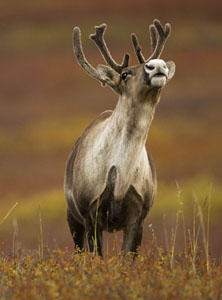
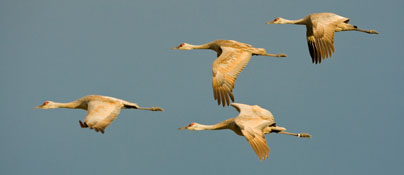
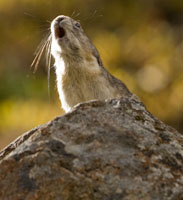
Willow Ptarmigan, grouse-like birds that our rusty red in summer and almost pure white in winter, eluded us this year, and the only ptarmigan we got close to was one we found on the road, headless with its breast picked clean, the victim of a gyrfalcon's attack. This was the first year we'd missed getting good shots of this handsome bird.
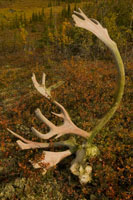 Another
favorite subject, the Caribou, taunted us. There was a great bull
in the Wonder Lake area, but we always returned to that area too
late in the day after a full day's excursion into the park. We
only saw it once, bedded down invitingly on the tundra rather
close to the road, but a storm was coming and the light, even
at ISO 800, was less than 1/60th of a second. We decided not to
shoot it and minutes after we left the storm arrived, reinforcing
the wisdom of that decision. We did film several nice bulls, including
a group of three in their 'nuptial coat' on the red tundra, but
none of these were the sought-after frame fillers most people
wanted. I had some luck with a young bull I'd spotted while Mary
and the group were filming landscapes one morning. The bull was
slowly moving in our direction but much too far away for a shot.
I decided to see if I could intercept it, and spent the next 15
minutes slogging through spongy wet tundra and incredibly thick
willows and dwarf birch. I never got close but the bull did, for
at one point it broke into an easy trot across this tiresome landscape
and ran right up to me. I had my 28-300 mounted, thinking I'd
get a habitat shot of the caribou and the Alaskan Range, and while
it ran up I quickly tried to change lenses to my 500. I succeeded
just as the caribou sauntered close, but by then I was so over-heated
from my walk that my glasses steamed up and I could barely see
the caribou. Nonetheless I shot, placing my AF point over the
caribou's face and trusting that the AF would do its job. It did,
and I was rewarded for my effort.
Another
favorite subject, the Caribou, taunted us. There was a great bull
in the Wonder Lake area, but we always returned to that area too
late in the day after a full day's excursion into the park. We
only saw it once, bedded down invitingly on the tundra rather
close to the road, but a storm was coming and the light, even
at ISO 800, was less than 1/60th of a second. We decided not to
shoot it and minutes after we left the storm arrived, reinforcing
the wisdom of that decision. We did film several nice bulls, including
a group of three in their 'nuptial coat' on the red tundra, but
none of these were the sought-after frame fillers most people
wanted. I had some luck with a young bull I'd spotted while Mary
and the group were filming landscapes one morning. The bull was
slowly moving in our direction but much too far away for a shot.
I decided to see if I could intercept it, and spent the next 15
minutes slogging through spongy wet tundra and incredibly thick
willows and dwarf birch. I never got close but the bull did, for
at one point it broke into an easy trot across this tiresome landscape
and ran right up to me. I had my 28-300 mounted, thinking I'd
get a habitat shot of the caribou and the Alaskan Range, and while
it ran up I quickly tried to change lenses to my 500. I succeeded
just as the caribou sauntered close, but by then I was so over-heated
from my walk that my glasses steamed up and I could barely see
the caribou. Nonetheless I shot, placing my AF point over the
caribou's face and trusting that the AF would do its job. It did,
and I was rewarded for my effort.
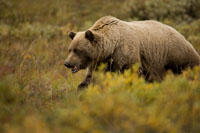
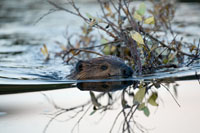
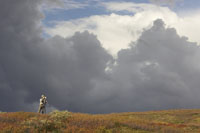
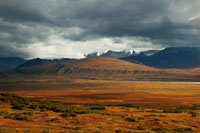
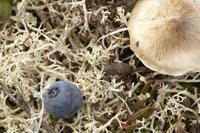 Because we had a patient
group that were not afraid to wait when necessary or to walk out
to a subject if that's what was needed, we had a superb trip,
probably the most successful Denali shoot we've ever had. On our
last full day, when we were confined to the Wonder Lake area,
we still had not shot any worthwhile tundra and macro shots, but
that morning we were lucky and we had a light rain and generally
overcast conditions -- perfect shooting conditions for doing macro
photography. We did our best work that day, as the tundra was
peaking in fall color. Mary used the 180mm macro lens she'd packed
for the trip and I used the two Tilt/Shift lenses I'd carried
expressly for this type of shooting. It was a great day, with
great shots.
Because we had a patient
group that were not afraid to wait when necessary or to walk out
to a subject if that's what was needed, we had a superb trip,
probably the most successful Denali shoot we've ever had. On our
last full day, when we were confined to the Wonder Lake area,
we still had not shot any worthwhile tundra and macro shots, but
that morning we were lucky and we had a light rain and generally
overcast conditions -- perfect shooting conditions for doing macro
photography. We did our best work that day, as the tundra was
peaking in fall color. Mary used the 180mm macro lens she'd packed
for the trip and I used the two Tilt/Shift lenses I'd carried
expressly for this type of shooting. It was a great day, with
great shots.
As mentioned, we stayed at the North Face Lodge where the staff
was great, the food was spectacular, and the logistics for our
travel were wonderful. Prior to doing this trip we thought that
this might be our last to Denali for several years but we were
wrong -- we loved it so much that we began making plans for another
trip in 2009 - the next time we could fit it in our schedule.